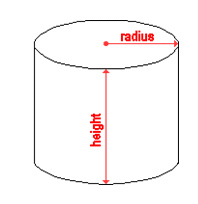When do I need to disinfect my cistern?
A cistern needs to be disinfected every time it gets cleaned.
Your cistern needs to be disinfected without cleaning at the following times:
- after being installed, even if no sediment or contaminants are at the bottom of the tank
- after plumbing maintenance work is done from the inside of the tank, such as replacing valves, pumps (Remember that anyone who enters a cistern needs to wear clean footwear.)
- when the source water that is delivered isn’t safe to drink
- when a bacteria test result comes back positive (Check the inside of the cistern if you don’t know the source of the bacteria.)
How much disinfectant do I need to use?
The amount of disinfectant you need depends on how much water the cistern holds. If you don’t have this information, you can estimate using the calculations below.
 Box cistern
Box cistern
To estimate how much water your box cistern can hold, you’ll need a calculator and the following measurements in metres:
- length (L)
- width (W)
- height (H)—the maximum depth of the water
Take these measurements and multiply them by each other: L x W x H. Then multiply the result by 1,000. The answer will tell you how many litres of water your cistern can hold, so you can figure out how much disinfectant to use.
Example
If a box cistern is 2.5 metres long, 1.5 metres high, and 1.7 metres wide, do the calculation like this: 2.5 x 1.5 x 1.7 = 6.38 metres3 6.38 x 1000 =
6380 litres (amount of water the cistern holds)
|
 Cylindrical cistern
Cylindrical cistern
To estimate how much water your cylindrical cistern can hold, you’ll need a calculator and the following measurements in metres:
- radius (the distance from the centre of the cylinder to the edge)
- height
Take the measurements and follow these steps:
- Step 1: Take the radius and multiply it by itself.
- Step 2: Take the result and multiply it by 3.14.
- Step 3: Take the next result and multiply it by the height.
- Step 4: Take this result and multiply it by 1,000.
The answer will tell you how many litres of water your cistern can hold, so you can figure out how much disinfectant to use.
| Example
If your cylindrical cistern has a radius of 1.1 metres and is 1.8 metres high, do the calculation like this:
Step 1: 1.1 x 1.1 = 1.21 Step 2: 1.21 x 3.14 = 3.8 Step 3: 3.8 x 1.8 = 6.84 Step 4: 6.84 x 1000 =
6840 litres (amount of water the cistern holds)
|
How do I disinfect a cistern?
When you’re ready to disinfect your cistern, bypass all water treatment devices and turn off the water heater. Then follow these steps:
- Start filling the cistern with clean, safe water.
- As you’re filling the cistern, add 1 litre of liquid, household, chlorine bleach (5.25%) for every 1,000 litres of water the cistern can hold. This gives a concentration of about 50 milligrams per litre of chlorine. Add the bleach as you fill the cistern so it mixes well with the water.
- Run each tap connected to the water distribution system until you can smell chlorine, and then close the tap.
- Let the chlorinated water sit in the cistern and the distribution system for at least
6 hours.
- After 6 hours, drain and dump the water to waste by following safe practices. Highly chlorinated water is
not safe to drink or give to animals. It will also cause problems if it’s dumped into septic fields.
- Refill the cistern with clean, safe water.
- Run each tap for at least 5 minutes to flush the distribution lines.
- Turn on the hot water heater. Follow the manufacturer’s instructions to service any water treatment devices
before you turn them back on.
- Test the water in the cistern, the distribution system, or both for bacteria. If there are no bacteria in the water sample, the water is
safe to drink.
If there are bacteria in the water sample, you need to find the source of contamination and fix the problem. Then you need to clean and disinfect the cistern again. If there are no bacteria in the next sample, the water is safe to drink.
